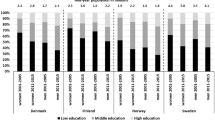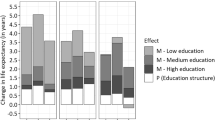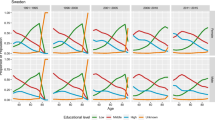Abstract
Educational attainment and longevity are strongly related. Large population studies covering long periods to provide evidence of trends in educational inequalities regarding life expectancy are scarce though, especially prior to the 1980s. Our objective was to document changes in life expectancy by education in Norway in the period 1961–2009, and to determine whether the patterns differ between sexes. This is a register-based population study of all Norwegian residents over 34 years, with data from the National Central Population Registry and the National Education Database. For each calendar year during 1961–2009, death rates by 1 year age groups were calculated separately for each sex and three educational categories (primary, secondary and tertiary). Annual life tables were used to calculate life expectancy at age 35 (e 35 ) and survival probability for the three age-intervals 35–44, 45–64, and 65–90. All education groups increased their e 35 over time, but inequalities in e 35 between tertiary and primary educational categories widened 5.3 years for men and 3.2 years for women during the study period. The probability for women with primary education to survive to age 64 did not improve from 1961 to 2009. The gain in life expectancy lagged about 10 years in lower compared to higher education groups which might suggest that improvements in life sustaining factors reach different segments of the population at different times. The widening of the gap seems to have partly tapered off over the last two decades, and the changes in life expectancy should be followed carefully in the future to document the development.



Similar content being viewed by others
References
Marmot Review. Fair society, healthy lives: strategic review of health inequalities in England post 2010. London: Marmot Review; 2010.
Singh GK, Siahpush M. Widening socioeconomic inequalities in US life expectancy, 1980–2000. Int J Epidemiol. 2006;35:969–79.
Valkonen T. The widening differentials in adult mortality by socio-economic status and their causes. In: Chamie J, Cliquet RL, editors. Issues of global concern. Proceedings of the symposium on “health and mortality”, Brussels 1997. Leuven: Flemish Scientific Institute; 1999. pp. 291–312.
Bronnum-Hansen H, Baadsgaard M. Increasing social inequality in life expectancy in Denmark. Eur J Public Health. 2007;17:585–6.
Deboosere P, Gadeyne S, Van Oyen H. The 1991–2004 evolution in life expectancy by educational level in Belgium based on linked census and population register data. European Journal of Population-Revue Europeenne de Demographie. 2009;25:175–96.
Eikemo TA, Bambra C. The welfare state: a glossary for public health. J Epidemiol Community Health. 2008;62:3–6.
Statistics Norway. www.ssb.no/english/. Oslo; 2012.
UNESCO. http://www.unesco.org/education/information/nfsunesco/doc/isced_1997.htm. 2012.
Chiang C. The life table and its applications. Florida: Robert E. Krieger Publishing Company; 1984.
National Institute of Public Health. http://www.norgeshelsa.no/norgeshelsa/?language=en. Oslo; 2012.
Report of the Advisory committee to the Surgeon General of the Public Health Service. PHS Publication No. 1103. Washington DC: US Public Health Service; 1964.
Act No.14 of 9 March 1973 relating to Prevention of the Harmful Effects of Tobacco. Oslo; 2010.
Ronneberg A, Lund KE, Hafstad A. Lifetime smoking habits among Norwegian men and women born between 1890 and 1974. Int J Epidemiol. 1994;23:267–76.
Report no 32 to the Storting (1975–1976) on Norwegian Nutrition and Food Policy. Oslo: Royal Norwegian Ministry of Agriculture; 1976.
Johansson L, Borgejordet A, Pedersen JI. Trans fatty acids in the Norwegian diet. Tidsskr Nor Laegeforen. 2006;126:760–3.
Link BG, Phelan J. Social conditions as fundamental causes of disease. J Health Soc Behav. 1995; Spec No: 80–94.
van Doorslaer E, Wagstaff A, van der Burg H, Christiansen T, De Graeve D, Duchesne I, Gerdtham UG, Gerfin M, Geurts J, Gross L, Hakkinen U, John J, Klavus J, Leu RE, Nolan B, O’Donnell O, Propper C, Puffer F, Schellhorn M, Sundberg G, Winkelhake O. Equity in the delivery of health care in Europe and the US. J Health Econ. 2000;19:553–83.
Iversen T, Kopperud GS. Regulation versus practice—the impact of accessibility on the use of specialist health care in Norway. Health Econ. 2005;14:1231–8.
Carlsen F, Kaarboe OM. Norwegian priority guidelines: estimating the distributional implications across age, gender and SES. Health Policy. 2010;95:264–70.
Gjonca A, Tomassini C, Toson B, Smallwood S. Sex differences in mortality, a comparison of the United Kingdom and other developed countries. Health Stat Q. 2005;26:6–16.
Strand BH, Groholt EK, Steingrimsdottir OA, Blakely T, Graff-Iversen S, Naess O. Educational inequalities in mortality over four decades in Norway: prospective study of middle aged men and women followed for cause specific mortality, 1960–2000. BMJ. 2010;340:c654.
Lund KE, Lund M, Bryhni A. Tobacco consumption among men and women 1927–2007. Tidsskr Nor Laegeforen. 2009;129:1871–4.
Lund M, Lindbak R. Norwegian tobacco statistics 1973–2006. Oslo: SIRUS—Norwegian Institute for Alcohol and Drug Research; 2007. Report No.: 3.
Cavelaars AE, Kunst AE, Geurts JJ, Crialesi R, Grotvedt L, Helmert U, Lahelma E, Lundberg O, Matheson J, Mielck A, Rasmussen NK, Regidor E, do Rosario-Giraldes M, Spuhler T, Mackenbach JP. Educational differences in smoking: international comparison. BMJ. 2000;320:1102–7.
Elstad JI, Torstensrud R, Lyngstad TH, Kravdal O. Trends in educational inequalities in mortality, seven types of cancers, Norway 1971–2002. Eur J Public Health. 2011. doi:10.1093/eurpub/ckr181
Antonovsky A. Social class, life expectancy and overall mortality. Milbank Mem Fund Q. 1967;45:31–73.
Pamuk ER. Social class inequality in mortality from 1921 to 1972 in England and Wales. Popul Stud (Camb). 1985;39:17–31.
Geyer S, Hemstrom O, Peter R, Vagero D. Education, income, and occupational class cannot be used interchangeably in social epidemiology. Empirical evidence against a common practice. J Epidemiol Community Health. 2006;60:804–10.
Hattersley L. Expectation of life by social class. [15], 73–82. 1997. London, The Stationery Office. Health Inequalities. Decennial Supplement. Drever, F and Whitehead, M. Ref Type: Serial (Book,Monograph).
Hattersley L. Trends in life expectancy by social class—an update. Health Stat Q. 1999;2:16–24.
Martikainen P, Valkonen T, Martelin T. Change in male and female life expectancy by social class: decomposition by age and cause of death in Finland 1971–95. J Epidemiol Community Health. 2001;55:494–9.
Klotz J. Convergence or divergence of educational disparities in mortality and morbidity? The evolution of life expectancy and health expectancy by educational attainment in Austria in 1981–2006. Vienna Yearb Popul Res. 2010;8:139–74.
Borrell C, Azlor E, Rodriguez-Sanz M, Puigpinos R, Cano-Serral G, Pasarin MI, Martinez JM, Benach J, Muntaner C. Trends in socioeconomic mortality inequalities in a southern European urban setting at the turn of the 21st century. J Epidemiol Community Health. 2008;62:258–66.
Harper S, Lynch J, Burris S, Davey SG. Trends in the black-white life expectancy gap in the United States, 1983–2003. JAMA. 2007;297:1224–32.
Acknowledgments
We would like to thank Statistics Norway for providing us with data and Cassie Trewin for language editing and valuable comments on the manuscript. This study was funded by the Norwegian Institute of Public Health and the University of Oslo and approved by the Norwegian Data Inspectorate. The funders had no role in the study design; collection, analysis, and interpretation of the data; writing of the report; or the decision to submit the article for publication.
Conflict of interest
We declare that we have no conflict of interest.
Ethical approval
Data linkage was approved by the Norwegian Data Inspectorate and data handling was approved by the Norwegian Directorate of Health.
Author information
Authors and Affiliations
Corresponding author
Rights and permissions
About this article
Cite this article
Steingrímsdóttir, Ó.A., Næss, Ø., Moe, J.O. et al. Trends in life expectancy by education in Norway 1961–2009. Eur J Epidemiol 27, 163–171 (2012). https://doi.org/10.1007/s10654-012-9663-0
Received:
Accepted:
Published:
Issue Date:
DOI: https://doi.org/10.1007/s10654-012-9663-0




